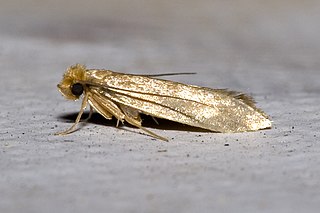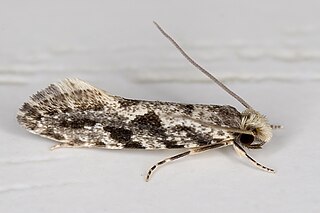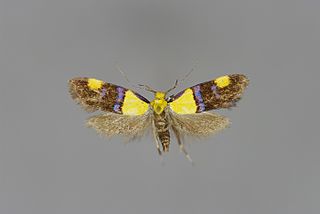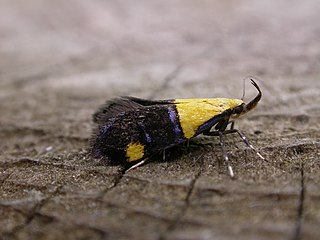
Tineola bisselliella, known as the common clothes moth, webbing clothes moth, or simply clothing moth, is a species of fungus moth. It is the type species of its genus Tineola and was first described by the Swedish entomologist Arvid David Hummel in 1823. It and a number of closely-related species are together known as the clothes moths due to their role as pests in human households. The specific name is commonly misspelled biselliella – for example by G. A. W. Herrich-Schäffer, when he established Tineola in 1853.

The white-shouldered house moth is a species of gelechioid moth. It belongs to the subfamily Oecophorinae of the concealer moth family (Oecophoridae), just like the brown house moth. Though several presumed congeners of E. sarcitrella were described, its genus Endrosis is currently understood to be monotypic.

Phalaena is an obsolete genus of Lepidoptera used by Carl Linnaeus to house most moths.

Acompsia is a genus of the twirler moth family (Gelechiidae). Though it has once been assigned to the proposed subfamily "Anacampsinae", it is generally placed in the Dichomeridinae. Some authors include Telephila here as a subgenus, while others prefer to keep it distinct as its relationships are fairly obscure.

Orthonama obstipata, the gem, is a moth of the family Geometridae. The species was first described by Johan Christian Fabricius in 1794. It is a cosmopolitan species. In continental Europe though in the northeast, its range does not significantly extend beyond the Baltic region and it is absent from northern Russia. This well-flying species is prone to vagrancy and able to cross considerable distances of the open sea; it can thus be regularly found on the British Isles and even on Iceland.

Scythropia crataegella, the hawthorn moth, is a species of moth in the monotypic genus Scythropia. It is found in western Eurasia.

Argyresthia curvella is a species of ermine moth. It belongs to subfamily Argyresthiinae, which is sometimes elevated to full family rank in the superfamily Yponomeutoidea. It is commonly called apple blossom tineid, reflecting the fact that it was originally believed to be a tineid moth.

Ethmia pusiella is a moth of the family Depressariidae. It occurs throughout Europe and eastwards to the Tien Shan mountains of eastern Central Asia.

Monopis obviella is a species of tineoid moth. It belongs to the fungus moth family (Tineidae), and therein to the nominate subfamily Tineinae. It is the type species of Blabophanes, today treated as a junior synonym of the genus Monopis. M. crocicapitella was only separated from the present species in 1859, and is still frequently confused with it even by rather recent sources.

Nemapogon granella is a species of tineoid moth. It belongs to the fungus moth family (Tineidae), and therein to the subfamily Nemapogoninae. It is the type species of its genus Nemapogon, and via that also of the subfamily Nemapogoninae. It is also the type species of the proposed genera Brosis and Diaphthirusa, which are consequently junior objective synonyms of Nemapogon.

Tinea semifulvella is a species of tineoid moth. It belongs to the fungus moth family (Tineidae), and therein to the nominate subfamily Tineinae. It is widespread and common in much of the western Palearctic, but seems to be absent from Portugal and the Balkans as well as the outlying islands. The nocturnal adults are on the wing around May to September, depending on the location, and are easily attracted to light sources.

Tinea pellionella, the case-bearing clothes moth, is a species of tineoid moth in the family Tineidae, the fungus moths. This species has a cosmopolitan distribution, occurring nearly worldwide.

The brown-dotted clothes moth is a species of tineoid moth. It belongs to the fungus moth family (Tineidae), and therein to the nominate subfamily Tineinae. It is the type species of its genus Niditinea.

Oecophora bractella is a species of gelechioid moth. It belongs to the subfamily Oecophorinae of the concealer moth family (Oecophoridae). As the type species of its genus Oecophora, its affiliations and phylogeny determine the delimitation of that family and subfamily.

Nemaxera is a genus of the fungus moth family, Tineidae. Therein, it belongs to the subfamily Nemapogoninae. The genus is considered monotypic, with the single species Nemaxera betulinella placed here.

Monopis laevigella, the skin moth, is a species of tineoid moth. It belongs to the fungus moth family (Tineidae), and therein to the nominate subfamily Tineinae. It is the type species of the genus Monopis and its junior objective synonym Hyalospila. As with the common clothes moth, earlier authors frequently misapplied the name Tinea vestianella to the present species.

Grapholita is a large genus of tortrix moths. It belongs to subfamily Olethreutinae, and therein to the tribe Grapholitini, of which it is the type genus.

Depressaria is a genus of moths in the superfamily Gelechioidea. It is the type genus of subfamily Depressariinae, which is often – particularly in older treatments – considered a distinct family Depressariidae or included in the Elachistidae, but actually seems to belong in the Oecophoridae.

Oecophora is a genus of the concealer moth family (Oecophoridae). Among these, it belongs to subfamily Oecophorinae. It is the type genus of its subfamily and family. Thus, regardless of the uncertain phylogeny, systematics and taxonomy of its superfamily Gelechioidea, it and its closest relatives always have to be assigned to this family and subfamily as long as these are deemed valid.

Tinea is a genus of the fungus moth family, Tineidae. Therein, it belongs to the subfamily Tineinae. As evident by its name, it is the type genus of its subfamily and family. Established as one of the first subgroups of "Phalaena", it used to contain many species of Tineidae that are nowadays placed in other genera, as well as a few moths nowadays placed elsewhere.





















